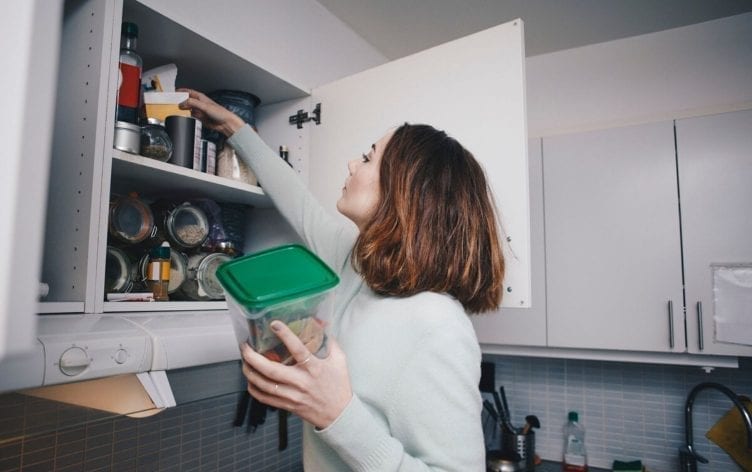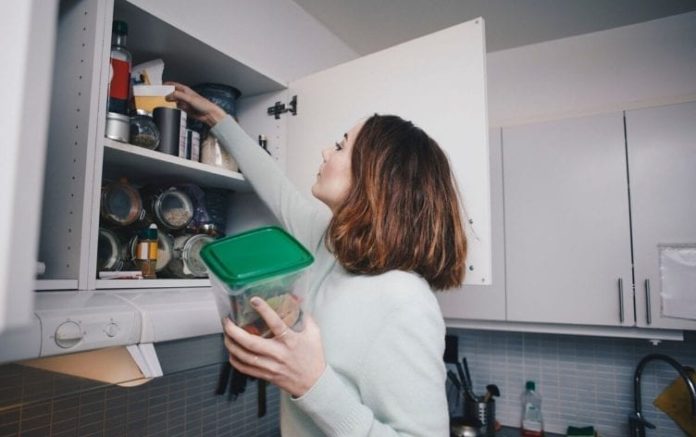
When it comes to weight-loss nutrition, figuring out what to eat (and how much of it) is half the battle. The other half is minimizing temptation and guesswork to give yourself a leg up. In fact, most people on a weight-loss journey don’t realize that by investing in the right tools and implementing subtle organizational hacks, they can actually put themselves in a great position for meeting their goals. And where better to start than the center of food in your home: the kitchen.
Here’s what nutrition pros recommend to optimize your cooking space to prioritize shedding pounds:
1
ARRANGE HEALTHY PANTRY PICKS FRONT AND CENTER
For many people, the eye-level pantry shelves are the go-to place to store chips, cookies and other packed, highly processed foods. However, that means the snacks you’re more likely to choose first are probably high in fat, salt, sugar and calories and low in fiber and protein. That’s because “Often you will choose what you see first,” explains Amy Goodson, RD.
Consider moving those less-nutritious choices to the highest and lowest shelves and placing healthier choices like nuts, dried fruits and whole-grain crackers on your most easily accessed shelves. By re-organizing your pantry you can help remove the temptation to reach for kryptonite snacks and prevent overeating.
2
REPURPOSE YOUR PRODUCE DRAWERS
If the produce bins are at the bottom of your refrigerator, you may be less inclined to reach for carrot sticks or an apple. “There’s no rule mandating that you use those out-of-the-way drawers for produce; they can actually be used to store meat, cheese or meal prep leftovers,” says Jessi Holden, RD. Instead, she recommends placing fruits and veggies in clear containers on shelves at eye-level, “so you see the vibrant colors first thing when you open the fridge.” This way, you’ll be more likely to reach for nutrient-dense fruits and veggies as a snack or when cooking.
3
STREAMLINE YOUR COUNTERS
Many people leave cereal boxes, home-baked snacks, chip bags and other frequently accessed foods on their kitchen counters. But some research shows people who keep food on the counter are more likely to have a higher BMI (body mass index). The only exception: A fruit bowl on the counter is associated with a lower BMI. To instill better eating habits, place your fruit bowl prominently on the counter and stash everything else in cabinets.
“Set yourself up for success rather than obstacles,” Holden says. “When we’re on auto-pilot and searching for snacks, our eyes eat first, so move those foods.”
4
THINK SMALL FOR PLATES AND UTENSILS
Smaller utensils, like teaspoons and salad forks, may help you consume fewer calories. One study found people who ate with teaspoons instead of larger spoons, consumed 8% less food. “Keep smaller forks and spoons on hand to help you slow down,” recommends Holden. “Eating too fast does not allow us to recognize if we’re still hungry, as it takes a while for the brain and stomach to connect.”
Similarly, smaller plates can help with portion control. Even if the meal is the same, “you may find it more satisfying to eat a very full-looking meal on a smaller plate compared to a sparse-looking dinner on a larger plate,” says Claudia Hleap, RD.
5
RETHINK HOW YOU MEASURE PORTIONS
For many people, portion control is a huge part of nailing the weight-loss equation, but it can be tough to put into practice, especially when you’re pressed for time. “Measuring out portions with measuring cups may even be too many steps,” says Monica Auslander Moreno, a registered dietitian. “You can buy plates, bowls and cups now with delineated serving sizes. It’s a rather eye-opening experience to realize you’re having five servings of your sweet potato puree at once. Even wholesome foods can be over portioned and lead to weight gain. Of note, there are wine glasses with these little etchings as well, which is a nice way to not overpour.”
6
INVEST IN AN OIL MISTER
Rather than drizzling food with oil straight from the bottle, use an oil mister for sauteing vegetables, cooking eggs and dressing salads, suggests Deborah Malkoff-Cohen, a registered dietitian. “A tablespoon of oil is 120 calories,” she adds. This is especially effective if you’re trying to reduce your fat intake. A mister you fill yourself is also a healthier option than pre-packaged oil sprays, Malkoff-Cohen notes, since they often contain additional ingredients like nonstick and anti-foaming agents as well as preservatives. Be sure to read the directions to find out how many sprays your mister uses per teaspoon or tablespoon, as each one is slightly different.
7
KEEP YOUR SPICE RACK STOCKED AND VISIBLE
“Have a good collection of spices on hand,” recommends Haley Hughes, a registered dietitian. “It’s a great way to change up flavors without the added calories. Sometimes sauces and toppings can add up quick.” If you’re getting bored with your go-to wholesome meals, “some new herbs and spices may be just the fix.”
8
LIMIT INDULGENCES
“Keep only one type of unhealthy snack food at a time,” suggests Lisa Young, PhD, a registered dietitian. The more variety we have on hand, the more we eat, she explains. By simply limiting your options, you’re more likely to avoid overeating.
9
BUY SINGLE-SERVE PORTIONS
This is especially true for healthy but highly caloric foods. “It makes you more likely to grab the food, eat the food and train your brain to understand what a ‘portion’ looks like,” Moreno says. “This is especially important with energy-dense items like nuts, nut butters, guacamole and hummus. It’s too easy to polish off that whole container of hummus in a sitting — and that could be something like six servings! All of these items now come in single-serve packets, and while I recognize the increased waste associated, I’d rather it be a temporary solution to guide clients’ eyes into appropriate portioning in hopes of future bulk buying/self-preparing.”
10
PORTION TEMPTING FOODS INTO SNACK-SIZE BAGS
If you can’t find your favorite snack foods in single portions, DIY them. “Many people will start snacking out of the bag, box or jar and eat way too much,” says Goodson. “When you get home from the grocery store, take a few minutes to ‘snack baggie’ these types of foods by serving size, that way the decision is made for you when you are hungry. A portion-controlled serving is ready to go.”
11
SET HYDRATION REMINDERS
Staying hydrated has been shown to help weight loss, especially since thirst can often be mistaken for hunger. Leave notes around the kitchen to honor healthy hydration habits. For instance, if you’re trying to drink less soda and more water, post a sticky on the fridge as a reminder to pour yourself a glass of H2O. You can also set out a water bottle or glass pitcher to serve as a visual cue to take more sips.
12
DON’T EAT FAMILY-STYLE
“Family-style eating can be tempting,” Goodson points out. “If you can reach for another spoon of this, scoop of that or piece of something, it is easier to overeat. Try leaving the food in the kitchen so you have to be more aware of getting second helpings. Having to leave the table will at least make you think twice.”
13
TURN TV TIME INTO MEAL-PREP TIME
If you can’t find time to prep healthy snacks or meals, try combining it with your nightly TV habit. “Cut vegetables during commercials if you watch TV shows in real-time to have for the next few days and keep accessible in the refrigerator as snacks,” Malkoff-Cohen suggests.
14
SIT DOWN TO EAT
Research shows eating while standing can be distracting, leading to overeating. Instead, take the time to sit down to eat. Put away phones or any other distractions and focus on the food you’re enjoying. “You’ll be more mindful and in touch with the fact that you’re fueling your body,” Holden says, which will help minimize overeating.
15
LEAVE YOURSELF A NOTE
“I often encourage clients to post sticky notes including their goals, healthy eating guidelines or whatever motivation visuals they can think of in the kitchen,” Hughes says. “Many of my clients struggle with stress or boredom eating so having those reminders can sometimes help them take a minute to stop and think about why they are eating.” Of course, if you’re truly hungry, go for it, but a quick reminder to yourself can help stop mindless eating in its tracks.










